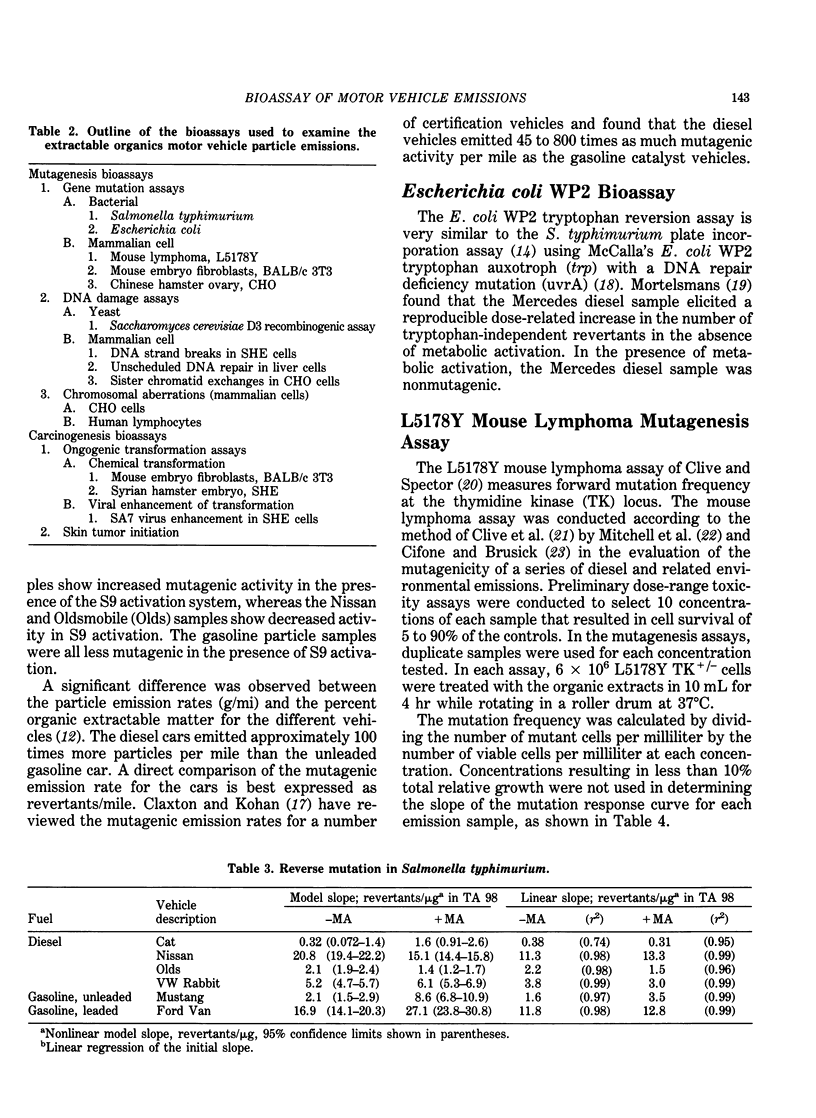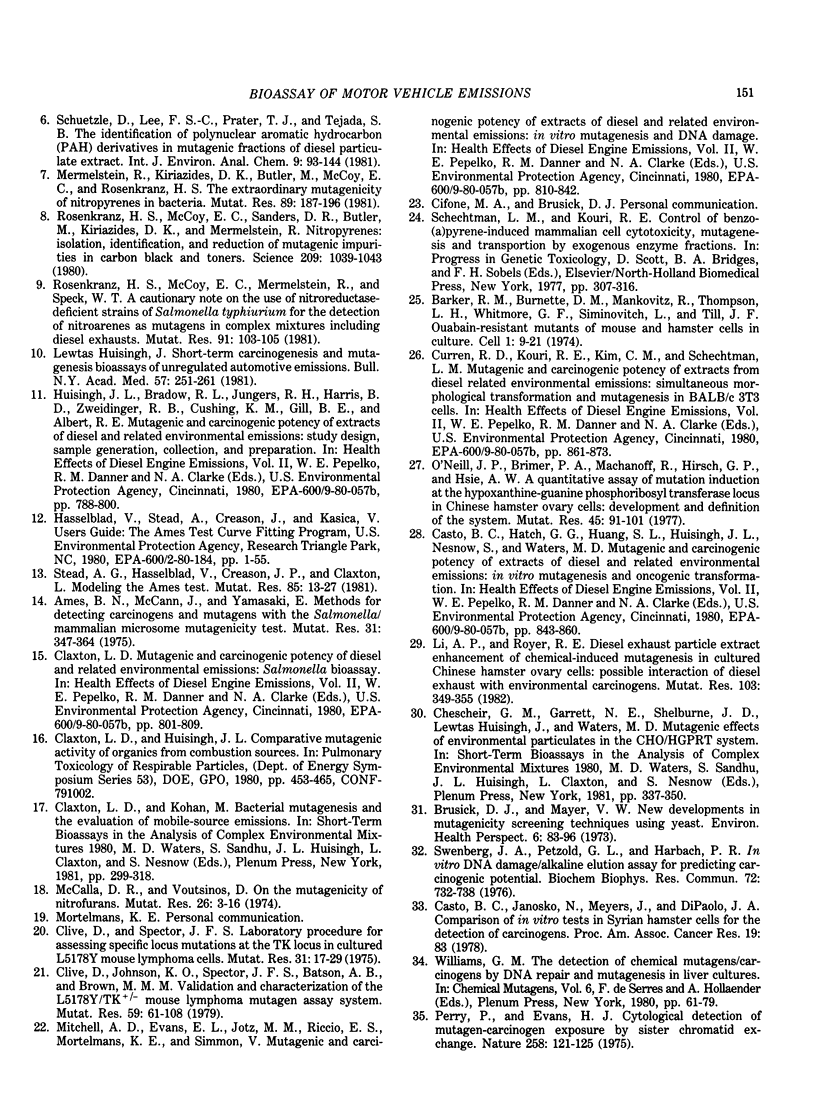Abstract
Incomplete combustion of fuel in motor vehicles results in the emission of submicron carbonaceous particles which, after cooling and dilution, contain varying quantities of extractable organic constituents. These organics are mutagenic in bacteria. Confirmatory bioassays in mammalian cells provide the capability of detecting chromosomal and DNA damage in addition to gene mutations. In order to evaluate the mutagenicity of these organics in mammalian cells, extractable organics from particle emissions from several diesel and gasoline vehicles were compared in a battery of microbial, mammalian cell and in vivo bioassays. The mammalian cell mutagenicity bioassays were selected to detect gene mutations, DNA damage, and chromosomal effects. Carcinogenesis bioassays conducted included short-term assays for oncogenic transformation and skin tumorigenesis. The results in different assay systems are compared both qualitatively and quantitatively. Good quantitative correlations were observed between several mutagenesis and carcinogenesis bioassays for this series of diesel and gasoline emissions.
Full text
PDF











Selected References
These references are in PubMed. This may not be the complete list of references from this article.
- Ames B. N., Mccann J., Yamasaki E. Methods for detecting carcinogens and mutagens with the Salmonella/mammalian-microsome mutagenicity test. Mutat Res. 1975 Dec;31(6):347–364. doi: 10.1016/0165-1161(75)90046-1. [DOI] [PubMed] [Google Scholar]
- Brusick D. J., Mayer V. W. New developments in mutagenicity screening techniques with yeast. Environ Health Perspect. 1973 Dec;6:83–96. doi: 10.1289/ehp.730683. [DOI] [PMC free article] [PubMed] [Google Scholar]
- Casto B. C., Pieczynski W. J., DiPaolo J. A. Enhancement of adenovirus transformation by pretreatment of hamster cells with carcinogenic polycyclic hydrocarbons. Cancer Res. 1973 Apr;33(4):819–824. [PubMed] [Google Scholar]
- Casto B. C., Pieczynski W. J., Janosko N., Dipaolo J. A. Significance of treatment interval and DNA repair in the enhancement of viral transformation by chemical carcinogens and mutagens. Chem Biol Interact. 1976 May;13(2):105–125. doi: 10.1016/0009-2797(76)90001-6. [DOI] [PubMed] [Google Scholar]
- Clive D., Johnson K. O., Spector J. F., Batson A. G., Brown M. M. Validation and characterization of the L5178Y/TK+/- mouse lymphoma mutagen assay system. Mutat Res. 1979 Jan;59(1):61–108. doi: 10.1016/0027-5107(79)90195-7. [DOI] [PubMed] [Google Scholar]
- Clive D., Spector J. F. Laboratory procedure for assessing specific locus mutations at the TK locus in cultured L5178Y mouse lymphoma cells. Mutat Res. 1975 Feb;31(1):17–29. doi: 10.1016/0165-1161(75)90059-x. [DOI] [PubMed] [Google Scholar]
- Huisingh J. L. Short-term carcinogenesis and mutagenesis bioassays of unregulated automotive emissions. Bull N Y Acad Med. 1981 May;57(4):251–262. [PMC free article] [PubMed] [Google Scholar]
- Li A. P., Royer R. E. Diesel-exhaust-particle extract enhancement of chemical-induced mutagenesis in cultured Chinese hamster ovary cells: possible interaction of diesel exhaust with environmental carcinogens. Mutat Res. 1982 Mar;103(3-6):349–355. doi: 10.1016/0165-7992(82)90066-5. [DOI] [PubMed] [Google Scholar]
- McCalla D. R., Voutsinos D. On the mutagenicity of nitrofurans. Mutat Res. 1974 Feb;26(1):3–16. doi: 10.1016/s0027-5107(74)80065-5. [DOI] [PubMed] [Google Scholar]
- McKenzie W. H., Knelson J. H., Rummo N. J., House D. E. Cytogenetic effects of inhaled ozone in man. Mutat Res. 1977;48(1):95–102. doi: 10.1016/0027-5107(77)90193-2. [DOI] [PubMed] [Google Scholar]
- Mermelstein R., Kiriazides D. K., Butler M., McCoy E. C., Rosenkranz H. S. The extraordinary mutagenicity of nitropyrenes in bacteria. Mutat Res. 1981 Jul;89(3):187–196. doi: 10.1016/0165-1218(81)90236-6. [DOI] [PubMed] [Google Scholar]
- Miller E. C. Some current perspectives on chemical carcinogenesis in humans and experimental animals: Presidential Address. Cancer Res. 1978 Jun;38(6):1479–1496. [PubMed] [Google Scholar]
- Nesnow S., Evans C., Stead A., Creason J., Slaga T. J., Triplett L. L. Skin carcinogenesis studies of emission extracts. Dev Toxicol Environ Sci. 1982;10:295–320. [PubMed] [Google Scholar]
- Nesnow S., Triplett L. L., Slaga T. J. Comparative tumor-initiating activity of complex mixtures from environmental particulate emissions on SENCAR mouse skin. J Natl Cancer Inst. 1982 May;68(5):829–834. [PubMed] [Google Scholar]
- O'Neill J. P., Brimer P. A., Machanoff R., Hirsch G. P., Hsie A. W. A quantitative assay of mutation induction at the hypoxanthine-guanine phosphoribosyl transferase locus in Chinese hamster ovary cells (CHO/HGPRT system): development and definition of the system. Mutat Res. 1977 Oct;45(1):91–101. doi: 10.1016/0027-5107(77)90047-1. [DOI] [PubMed] [Google Scholar]
- Pereira M. A. Genotoxicity of diesel exhaust emissions in laboratory animals. Dev Toxicol Environ Sci. 1982;10:265–276. [PubMed] [Google Scholar]
- Perry P., Evans H. J. Cytological detection of mutagen-carcinogen exposure by sister chromatid exchange. Nature. 1975 Nov 13;258(5531):121–125. doi: 10.1038/258121a0. [DOI] [PubMed] [Google Scholar]
- Rosenkranz H. S., McCoy E. C., Mermelstein R., Speck W. T. A cautionary note the use of nitroreductase-deficient strains of Salmonella typhimurium for the detection of nitroarenes as mutagens in complex mixtures including diesel exhausts. Mutat Res. 1981 Mar;91(2):103–105. doi: 10.1016/0165-7992(81)90080-4. [DOI] [PubMed] [Google Scholar]
- Rosenkranz H. S., McCoy E. C., Sanders D. R., Butler M., Kiriazides D. K., Mermelstein R. Nitropyrenes: isolation, identificaton, and reduction of mutagenic impurities in carbon black and toners. Science. 1980 Aug 29;209(4460):1039–1043. doi: 10.1126/science.6996095. [DOI] [PubMed] [Google Scholar]
- Schuetzle D., Lee F. S., Prater T. J. The identification of polynuclear aromatic hydrocarbon (PAH) derivatives in mutagenic fractions of diesel particulate extracts. Int J Environ Anal Chem. 1981;9(2):93–144. doi: 10.1080/03067318108071903. [DOI] [PubMed] [Google Scholar]
- Stead A. G., Hasselblad V., Creason J. P., Claxton L. Modeling the Ames test. Mutat Res. 1981 Feb;85(1):13–27. doi: 10.1016/0165-1161(81)90282-x. [DOI] [PubMed] [Google Scholar]
- Swenberg J. A., Petzold G. L., Harbach P. R. In vitro DNA damage/alkaline elution assay for predicting carcinogenic potential. Biochem Biophys Res Commun. 1976 Sep 20;72(2):732–738. doi: 10.1016/s0006-291x(76)80100-3. [DOI] [PubMed] [Google Scholar]


